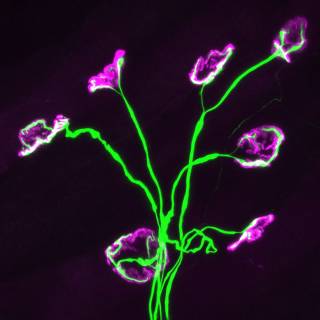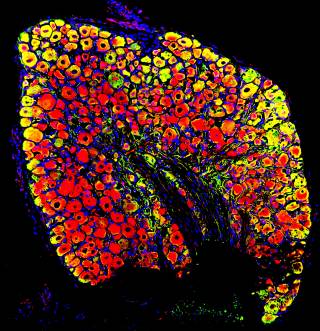The fundamental question driving our research in the Sleigh Lab, is ‘how do mutations in widely expressed genes cause selective peripheral nerve dysfunction and degeneration?' Mutations in many different genes required throughout the body manifest in a very specific detrimental effect on motor and sensory nerves, and we want to better understand the molecular and cellular mechanisms that cause this.
Charcot-Marie-Tooth disease (CMT) is the most common inherited neuromuscular disorder and is the principal focus of our research.
Caused by mutations in more than 90 different genes, CMT is a genetically diverse group of peripheral neuropathies characterised by progressive motor and sensory nerve dysfunction leading to muscle weakness and sensory impairment. The gene family linked to more subtypes of CMT than any other, encodes the aminoacyl tRNA-synthetase (ARS) enzymes, which charge specific amino acids to their cognate transfer RNAs (tRNAs), thereby priming the tRNAs for protein translation. To date, dominant, missense mutations in five ARS-encoding genes (GARS, YARS, AARS, HARS, and WARS) have been identified to cause CMT. However, whether these CMT subtypes result from the same or similar pathomechanisms remains to be resolved.
We primarily work on GARS and YARS. GARS encodes glycyl-tRNA synthetase (GlyRS), which charges glycine, and is the first and best studied ARS gene linked to CMT (designated CMT type 2D, CMT2D). Similarly, dominantly inherited mutations in the tyrosyl-tRNA synthetase (TyrRS)-encoding YARS gene cause dominant intermediate CMT (DI-CMT). The housekeeping function of aminoacylation explains the widespread and constitutive expression of GARS and YARS, but how do mutations that affect proteins found in all cells selectively trigger peripheral neurodegeneration?
Using CMT as a paradigm, the Sleigh Lab is studying causes of motor and sensory nerve deterioration and the mechanisms underpinning the dynamic cellular process of axonal transport. By improving understanding of neuropathic pathways and associated pathologies, we aim to generate pre-clinical molecular therapies for genetic peripheral nerve diseases. Additionally, by researching relatively rare conditions, we expect to make key discoveries about the cellular processes and pathways essential to neuronal homeostasis and viability.


 Close
Close

